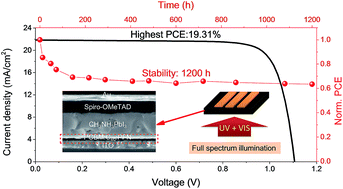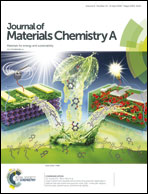A ternary organic electron transport layer for efficient and photostable perovskite solar cells under full spectrum illumination†
Abstract
Perovskite solar cells using titanium dioxide (TiO2) for electron extraction have achieved high efficiency, but tend to degrade under full spectral illumination due to ultraviolet (UV) photocatalysis. PCBM might be an alternative candidate to overcome this instability issue, however, its PSC efficiency is still low due to relatively poor electrical conductivity and contact interface barriers with the electrode. Here, we demonstrate that the addition of C60 and self-organized PFN to PCBM as a ternary electron transport layer (ETL) can effectively improve the device performance by enhancing the conductivity and buffering the interfacial contact simultaneously. As a result, the highest hysteresis-free power conversion efficiency (PCE) of 19.31% has been achieved. Furthermore, the device based on ternary PCBM:C60:PFN can retain 91.3% of its initial PCE over 1056 hours of continuous full spectral illumination after a “burn in” period and thus shows a more stable performance than TiO2 based PSCs. This low-temperature (≤100 °C) prepared ternary material may offer the possibility of roll-to-roll mass production on flexible substrates and achieve highly photo-stable PSCs under full spectral illumination without the requirement of an additional UV filter.



 Please wait while we load your content...
Please wait while we load your content...